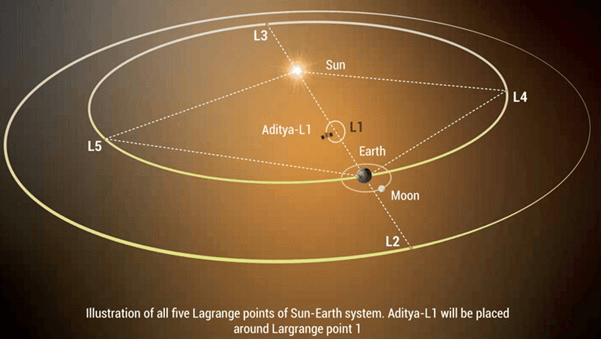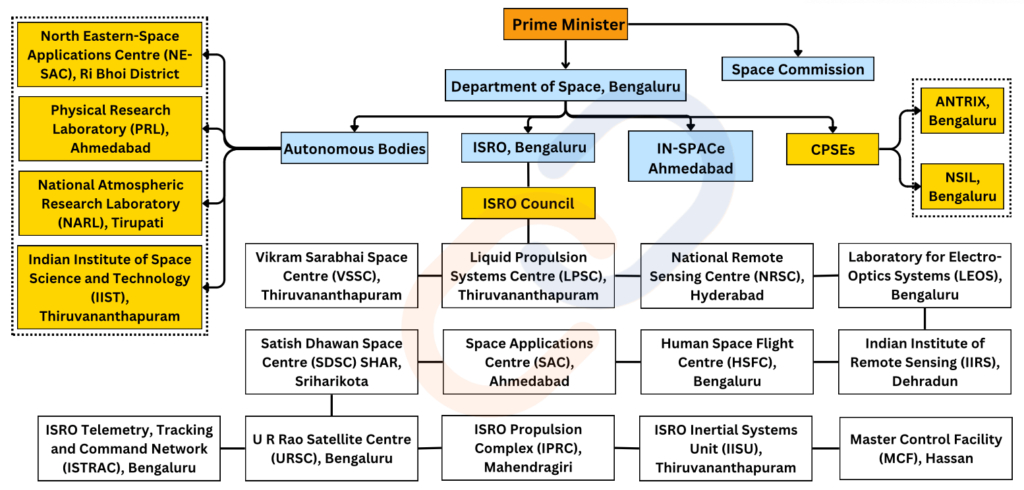Indian Space Programme is a remarkable example of India’s progress in the field of Technology. Initiated in the 1960s, it has grown to achieve global recognition through satellite launches, space exploration, and remote sensing capabilities. This programme highlights how technological innovation can drive national development and self-reliance.
Indian Space Programme
Key Milestones in Indian Space History
| Phase | Year | Milestone | Details |
| Early Beginnings | 1940s | Pre-ISRO Era | India’s space interest initiated by Dr. Vikram Sarabhai and Dr. Homi J. Bhabha. |
| 1962 | Formation of INCOSPAR | Indian National Committee for Space Research (INCOSPAR) was formed under Dr. Sarabhai and the Department of Atomic Energy. | |
| 1963 | Thumba Equatorial Rocket Launching Station (TERLS) | Established in Thiruvananthapuram for launching sounding rockets. | |
| 1963 | First Rocket Launch | Nike-Apache was launched from Thumba, marking the beginning of India’s space program. | |
| Growth Phase | 1969 | Establishment of ISRO | ISRO replaced INCOSPAR to broaden India’s space research. |
| 1972 | ISRO under the Department of Space | ISRO was placed under DOS for better integration of space activities. | |
| 1975 | First Satellite: Aryabhata | Launched from the Soviet Union; conducted experiments in aeronomy, solar physics, and X-ray astronomy. | |
| 1979 | Bhaskara I | Experimental remote sensing satellite to study hydrology, oceanography, and forestry. | |
| 1980 | SLV Program | India launched Rohini-1 into orbit using SLV-3, becoming the 7th country to do so independently. | |
| 1983 | INSAT Series | Established to meet telecommunication, broadcasting, and meteorological needs. INSAT-1A (1982) failed in orbit. | |
| 1988 | IRS Series | IRS-1A was launched, marking the start of India’s Earth observation program. | |
| 1990s | GSLV and PSLV Development | Development of PSLV and GSLV began; GSLV’s first success was in 2003. | |
| Global Recognition | 2001 | GSAT Series | GSAT-1 launched to provide telecommunication and broadcasting services. |
| 2008 | Chandrayaan-1 | India’s first lunar mission placed the country in the league of outer space explorers. | |
| 2013 | Mars Orbiter Mission (Mangalyaan) | India became the first Asian country to reach Mars orbit and the first globally to do so on its first attempt. | |
| 2017 | Record Satellite Launch | ISRO launched 104 satellites on a single PSLV rocket, setting a world record. | |
| 2019 | Chandrayaan-2 | The orbiter sent valuable data, though the Vikram lander lost communication during its descent. | |
| 2020 | Gaganyaan (Human Spaceflight Program) | India’s first crewed space mission under development; the first mission is expected by 2026. | |
| 2023 | Chandrayaan-3 | Achieved a successful soft landing near the Moon’s south pole, a global first. | |
| 2024 | Aditya-L1 | India’s first mission to study the Sun, focused on solar atmosphere and magnetic storms. |
Aditya L1 mission

Aditya-L1, the first Indian space-based observatory to study the sun, was launched on September 2, 2023, from the Satish Dhawan Space Centre in Sriharikota using the PSLV C57 rocket. Recently, it was successfully placed in a halo orbit around the L1 Lagrangian point.
Objectives
- Study of Solar upper atmospheric (chromosphere and corona) dynamics
- Physics of coronal heating mechanisms and reasons behind extreme temperatures.
- Understanding the initiation and dynamics of Coronal Mass Ejections (CMEs)
- Investigation into the magnetic field of the solar corona and its role in driving space weather.
- Examination of particle acceleration on the Sun leading to solar wind generation.
- Identify the sequence of processes that occur at multiple layers (chromosphere, base and extended corona) which eventually leads to solar eruptive events.
Significance

It Carries seven payloads (SUIT, PAPA, HEL1OS, VLEC etc) to observe the photosphere, chromosphere, and corona using electromagnetic and particle detectors.
- Understanding the solar corona’s dynamics is crucial for comprehending solar variability and its impacts on Earth’s climate.
- Capturing Full disk image of the Sun : by Observing UV radiation from different solar atmosphere zones.
- Discern the roles of natural and anthropogenic factors in climate change.
- Observing the Sun 24X7 : Aditya-L1 continuously views the Sun without occultation or eclipse, allowing unobstructed observation of solar activities
- Functions as a space weather station :
- Solar storms, including solar flares and CMEs, can disrupt GPS, communication systems, and satellite electronics. → Data from Aditya L1 aids in predicting geomagnetic storms and understanding space weather dynamics, crucial for protecting satellites and space assets.
- Enhancing nuclear fusion energy research
- Future Solar Exploration: Lays the foundation for future missions like Aditya-L2 (for Sun’s far side imaging) and Aditya-L3 in highly elliptical orbits.
Gaganyaan Mission
Objective: The Gaganyaan project aims to demonstrate human spaceflight capability by launching a crew of three members into an orbit of 400 km for a three-day mission and safely bringing them back to Earth by landing in the Indian sea waters.
- Two unmanned missions precede the final manned mission for safety. The first unmanned test flight (Gaganyaan-1 mission) is scheduled by 2024.
Launch vehicle: The Human Rated LVM-3 (GSLV Mk III) → ISRO has reconfigured all components of LVM3 to meet human rating requirements.
Orbital Module (OM): It will orbit Earth, comprising the Crew Module (CM) and Service Module (SM).
Tests Planned :
- Integrated Air Drop Test (IADT): Indian Air Force drops a 5-ton dummy crew module.
- Pad Abort Test (PAT): Ensures quick escape from rocket in case of failure.
- Crew Abort Test Mission: Simulates abort conditions during ascent.
- Vyomitra: Humanoid robot for microgravity experiments and monitoring.
- Manned Flight: Final mission with human astronaut, landing in the Arabian Sea off Gujarat.
Moon Missions
Chandrayaan 3
India made history by becoming the first country to land on the lunar south pole and the fourth country to place a rover on the moon with its Lunar Mission “Chandrayaan 3” on August 23, 2023.
- ISRO’s second attempt for Moon exploration, under the Chandrayaan-2 mission, partially failed in 2019. After the crash-landing of Chandrayaan-2 on the surface of the Moon, ISRO has changed and upgraded the Chandrayaan-3 spacecraft in order to achieve success.
| Objectives | Previous Missions | Chandrayaan-3 |
| Safe and Soft landing | Chandrayan 2 failed (crash landing of Vikram lander ) | Demonstration of a Safe and Soft Landing on the Lunar Surface |
| Roving on the lunar surface | rover Pragyan could not be deployed | Deployed the rover to explore the cratered surface, harnessed integrated cameras to send back videos of its environment |
| conduct in-situ scientific experiments. | Could not perform. | Underway ⇒ All payloads are performing normally. |
| Exo-Planet | Not focussed | Propulsion Module has a payload — SHAPE |
| Technology Validation | Limited to soft landing | HOP experiment : Future possibility of coming back from the moon. |
Major Subsystems :
- Chandrayaan-3 consists of an indigenous Lander module (Vikram), Propulsion module (PM) and a Rover (Pragyan) with an objective of developing and demonstrating new technologies required for Interplanetary missions.
- Communication Systems: to relay data between the spacecraft and mission control on Earth. (ESA’s ESTRACK network and NASA’ Deep Space Network is providing communication support)
- Navigation and Guidance Systems: for precise control of the spacecraft’s trajectory and landing.
- Power Systems: Use of solar power to make the Rover functional for 1 lunar day (14 earth days).
- Scientific Instruments:
Propulsion Module Payload:
- Spectro-polarimetry of HAbitable Planet Earth (SHAPE)
- Objective : Explore smaller planets in reflected light for habitability and potential presence of life.
Lander Payloads:
- Radio Anatomy of Moon Bound Hypersensitive ionosphere and Atmosphere (RAMBHA)
- Objective: Measure near-surface plasma density and its changes over time using Langmuir probe (LP).
- Chandra’s Surface Thermo physical Experiment (ChaSTE)
- Objective: Measure thermal properties of lunar surface near polar region.
- Instrument for Lunar Seismic Activity (ILSA)
- Objective: Measure lunar seismic activity and delineate lunar crust and mantle structure.
- LASER Retroreflector Array (LRA)
- Objective: Passively study dynamics of Moon system.
Rover Payloads:
- LASER Induced Breakdown Spectroscope (LIBS)
- Objectives: to derive the chemical composition of the moon surface
- Alpha Particle X-ray Spectrometer (APXS)
- Objectives: Determine elemental composition of Lunar soil and rocks around landing site.
Significance of this achievement for india
- Joins the elite Group: India became the fourth country to master the technology of soft-landing on the moon’s surface after the US(Apollo 11 mission in 1969), China(Chang’e 3 and 4), and the former Soviet Union(Luna 9 in 1966).
- India as a space exploration player :we will be part of all decision-making related to future planetary explorations and even extraction of resources from space.
- Entry into the moon economy : Space Tourism and Economic Opportunities
- Technological Advancement:
- The knowledge obtained from this mission will assist future launches, including Shukrayaan, Gaganyaan, and Aditya-L1.
- Technologies translate into commercial products → autonomous rovers for disaster management and infrastructure monitoring.
- Advancements in technology, from altimeters to hazard detection systems
- Unleashing Scientific Discoveries: through 7 payloads
- provided vital data about the lunar surface, including the presence of sulfur and other minor elements, as well as surface temperature.
- Data gathered from the mission has implications for lunar resource utilization and future habitation plans.
- Strategic and Geopolitical Significance
- India’s achievement can help meet and scale up some of the goals of the Artemis program, to include lunar resource utilization.
- India plans to collaborate with Japan in 2026 for the Lunar Polar Exploration Mission (LUPEX), also known as Chandrayaan 4. The mission aims to confirm the presence of water ice on the Lunar South Pole and analyze its quality and quantity. This data is crucial for life support and generating rocket fuel.
- Learning from failures : resilience
In conclusion, Chandrayaan-3’s endeavors mark significant milestones for India’s space exploration journey. From showcasing technological prowess and leadership in space to unraveling the mysteries of celestial bodies like the Moon.
Venus Orbiter Mission (Shukrayaan Mission)
- The Venus Orbiter Mission of ISRO is scheduled to launch in March 2028.
- It is only an orbiter mission.
- Goal: To explore the planet’s atmosphere, surface, and its interaction with the Sun.
- It will carry the first ground-penetrating radar to Venus.
- Shukrayaan-I will be launched on either GSLV Mk II or GSLV Mk III.
- The scientific payloads / experiments : 16 Indian payloads, 2 Indian and international collaborative payloads, and one international payload.
- Name of few Indian payloads:
- Venus Surface Emissivity and Atmospheric Mapper (VSEAM)
- Lightning Instrument for VEnus (LIVE)
- VEnus THermosphere Ionosphere composition Analyser (VETHICA)
- Venusian Electron temperature and Density Analyser (VEDA)
- Venus Ionospheric Plasma wave detectoR (VIPER)
- Indian and international collaborative payloads
- Venus Ionospheric and Solar Wind particle AnalySer (VISWAS)
- Radio Anatomy of Venus Ionosphere (RAVI)
- International payload
- VIRAL (Venus InfraRed Atmospheric gases Linker)
- Name of few Indian payloads:
Institutional Setup

Indian National Space Promotion and Authorization Center (IN-SPACe)
- Established in June 2020.
- HQ – Bopal, Ahmedabad
- It is a single-window, independent, nodal agency that functions as an autonomous agency in the Department of Space (DOS).
- It is formed following the Space sector reforms to enable and facilitate the participation of private players.
- It will permit and oversee the following activities of Non-Government-Private-Entities (NGPEs):
- Space activities including building of launch vehicles and satellites and providing space based services as per the definition of space activities.
- Sharing of space infrastructure and premises under the control of ISRO with due considerations to on-going activities.
- Establishment of new space infrastructure and facilities by NGPEs.
Antrix Corporation Limited, Bengaluru
- Incorporated as a private limited company in September 1992.
- It is a wholly owned Government of India Company under the administrative control of the Department of Space.
- Marketing arm of ISRO for promotion and commercial exploitation of space products, technical consultancy services and transfer of technologies developed by ISRO.
- As the commercial and marketing arm of ISRO, Antrix is engaged in providing Space products and services to international customers worldwide.
NewSpace India Limited (NSIL), Bengaluru
- Incorporated on 6 March 2019 (under the Companies Act, 2013).
- It is a wholly owned Government of India company, under the administrative control of the Department of Space (DOS).
- The commercial arm of ISRO.
- NSIL is responsible for promoting and commercializing products and services from the Indian space program.
- NSIL’s business areas include building satellites, producing launch vehicles, and marketing space-based services.
Indian Space Association (ISpA)
- Founded in October 2021.
- ISpA is an apex non-profit industry body, setup exclusively for the successful collaborative development of the Private Space Industry in India.
- ISpA was created to be the single Voice of the Private Space Industry and act as a bridge between the Government and the Private Industry.
Space Technology and National Security in India
- Role of Satellites in Defense: RISAT, GSAT-7 (Rukmini).
- Mission Shakti: India’s Anti-Satellite (ASAT) Weapon Test.
- Cybersecurity Challenges in Indian Space Assets.
- Future Prospects: Space-based surveillance, defense satellites for hybrid warfare.
International Space Station
- Modular space station (habitable artificial satellite) and the single largest man-made structure in low Earth orbit.
- Serves as a microgravity and space environment research laboratory
- Launched in 1998, it is a multinational collaborative project involving five space agencies:
- NASA (United States)
- Roscosmos (Russia)
- JAXA (Japan)
- ESA (Europe)
- CSA (Canada)
Tiangong
- China’s space station
- First module, Tianhe, launched in 2021.
- A Chinese spaceship “Shenzhou-12” carrying a three-person crew docked with China’s new space station module Tianhe-1.
Note:ISRO is working to set up Bhartiya Antariksh Station by 2035.
Challenges and Opportunities in Indian Space Technology
Challenges:
- Funding Constraints and Balancing Priorities.
- Space Debris and India’s Mitigation Efforts.
- Competition from Global Space Giants and Private Players.
Opportunities:
- Indian Startups in Space: Skyroot, Pixxel, Agnikul.
- Public-Private Partnership: Role of IN-SPACe.
- Moon, Mars, and Beyond: India’s ambitions in deep space exploration.
- Emerging Areas: Space tourism, mining, and solar power satellites.
Private Sectors/Startups
Digiantra Research and Technology
- A space tech startup founded by Lovely Professional University alumni (Anirudh Sharma & Rahul Rawat) in 2018.
- It has developed India’s first In-orbit Space Debris Monitoring and tracking system, which is based on LIDAR (Light Detection and Ranging) technology.
- India’s first commercial Space Situational Awareness (SSA) Observatory will be set up in the Garhwal region of Uttarakhand.
OKAPI Orbits
- Creating a Space Situational Awareness Platform providing services for safe satellite operations in an increasingly crowded space environment.
Agnibaan SubOrbital Technology Demonstrator (SOrTeD)
- Launched by IIT Madras based start-up Agnikul Cosmos
- World’s first rocket powered by a fully 3D-printed engine.
Vikram-S
- India’s first privately built rocket was launched on 18 November 2022 by Skyroot Aerospace from Sriharikota।
- The first mission of the rocket launch has been designated as ‘Prarambh’.
Indian Space Policy 2023
- The Indian Space Policy 2023 delineates roles in the space sector.
- Vision: To augment space capabilities; enable, encourage and develop a flourishing commercial presence in space; use space as a driver of technology development and derived benefits in allied areas; pursue international relations, and create an ecosystem for effective implementation of space applications among all stakeholders.
- Focus: It emphasizes R&D to keep India at the forefront.
- ISRO: ISRO to focus on applied research, tech dev, and human spaceflight.
- Scope: Applicable to all space activities in or from Indian Territory.
- Includes exclusive economic zone.
- IN-SPACe shall function as an autonomous Government organization, mandated to promote,hand-hold, guide and authorize space activities in the country.
Space Debris
- The Low Earth Orbit (LEO) environment is becoming increasingly congested with space debris due to the high frequency of object launches.
Causes and Risks
- Kessler Syndrome: It is a theoretical scenario where collisions between space debris in low Earth orbit (LEO) create a chain reaction that makes the orbit unusable.
- NASA’s Orbital Debris Program currently tracks over 25,000 objects larger than 10 cm in LEO.
|
Debris Sources |
Debris Sinks |
|
|
Initiatives to Deal with Space Debris
- ISRO System for Safe & Sustainable Operations Management (IS4OM)
- Launched in 2022 by ISRO.
- It is a control center set up in Bangalore to trace, track, deflect and remove space debris harmful to space assets.
- It is aimed at improving India’s Space Situational Awareness & Management (SSAM) in view of increasing space debris
- Project NETRA (Network for space object Tracking and Analysis)
- An early warning system in space to detect debris and other hazards to Indian satellites.
- A project of ISRO.
- Debris Free Space Missions (DFSM)
- Announced in April 2024 by ISRO.
- This initiative aims to achieve debris-free space missions by all Indian space actors, governmental and non-governmental by 2030.
- Terminator Tape
- To tackle the problem of space debris, a company called Tethers Unlimited has demonstrated an easy solution to get rid of satellites once they are of no use.
- The solution involves a 230-feet long strip of conductive tape, which is delightfully called the Terminator Tape.
